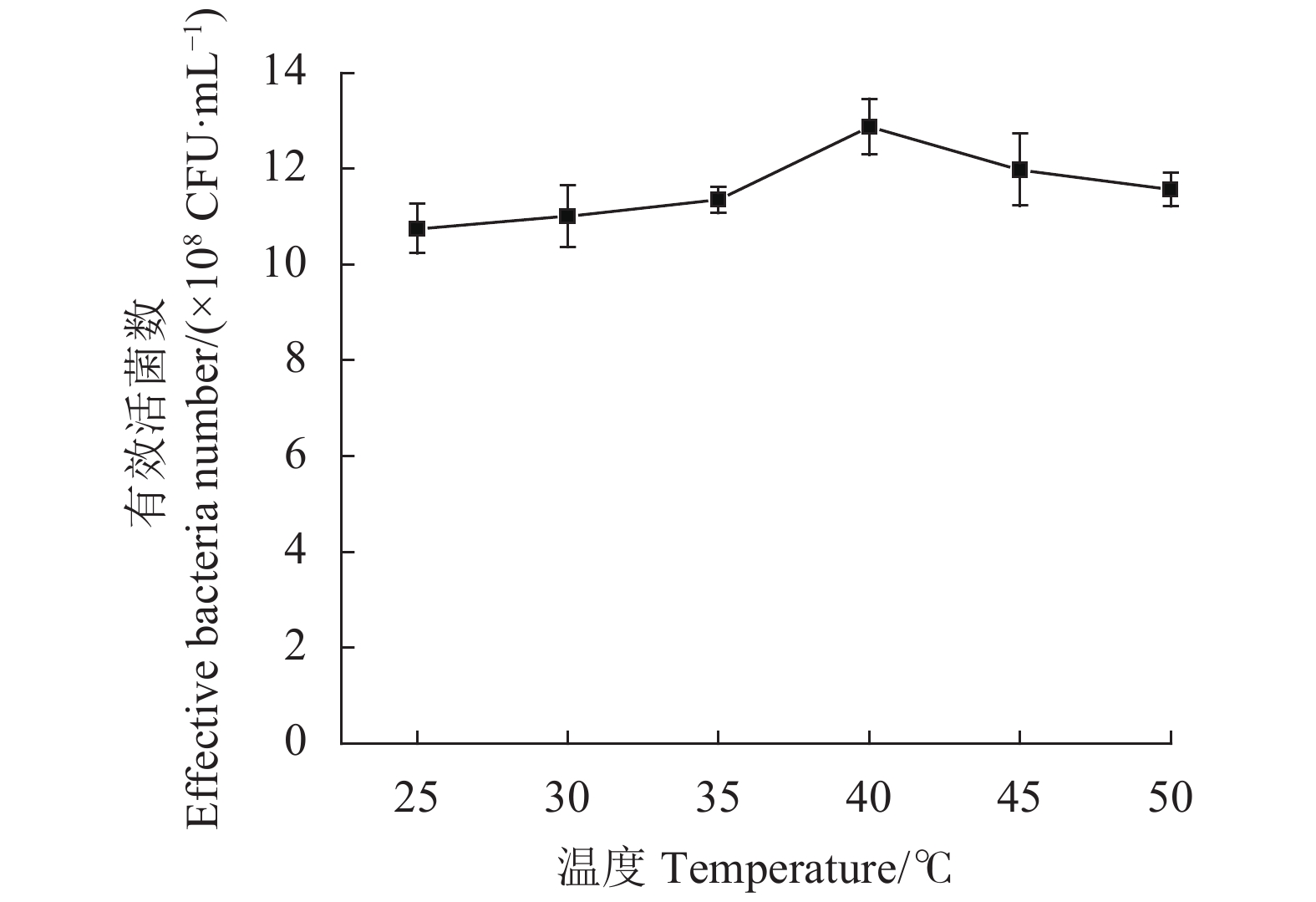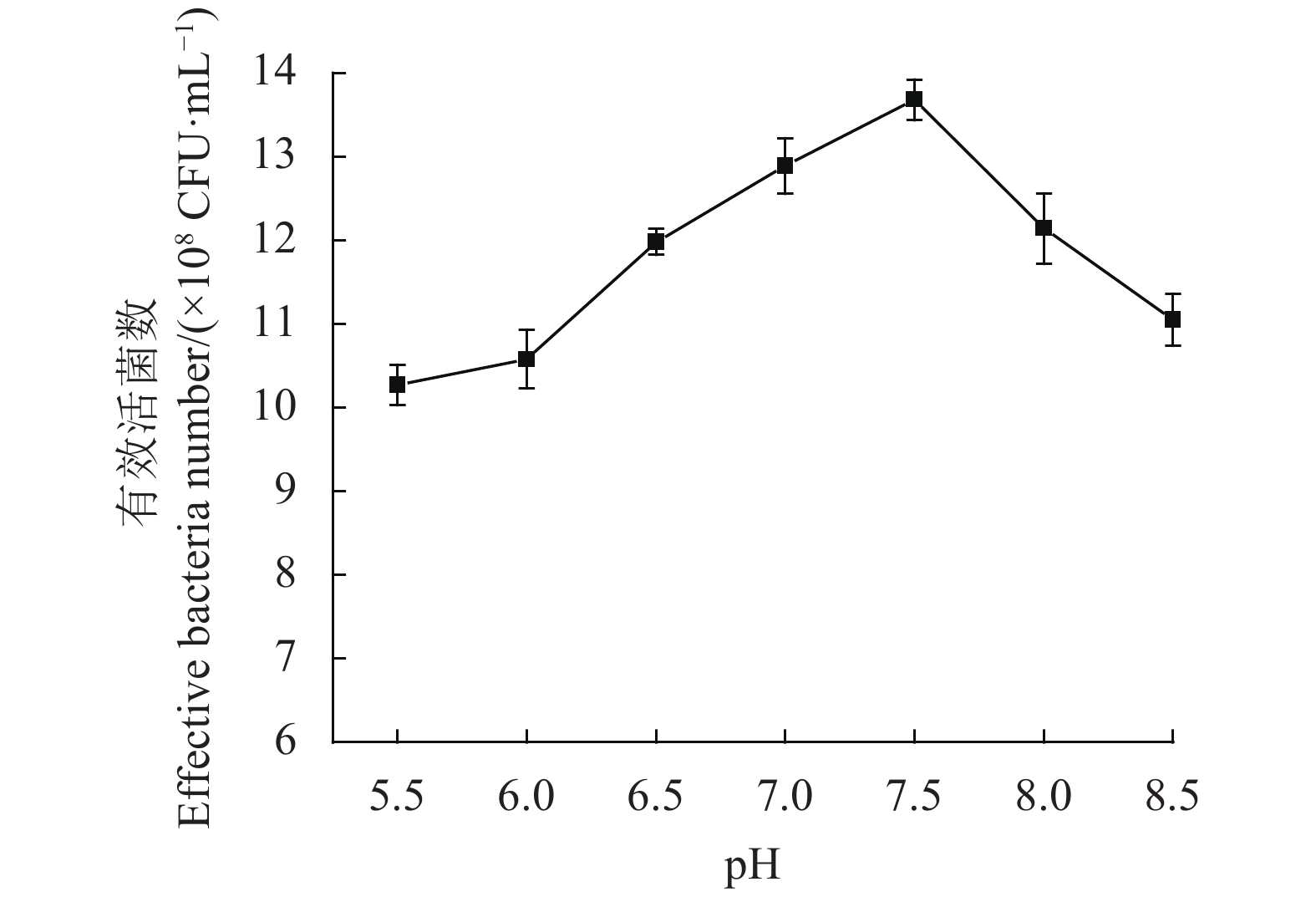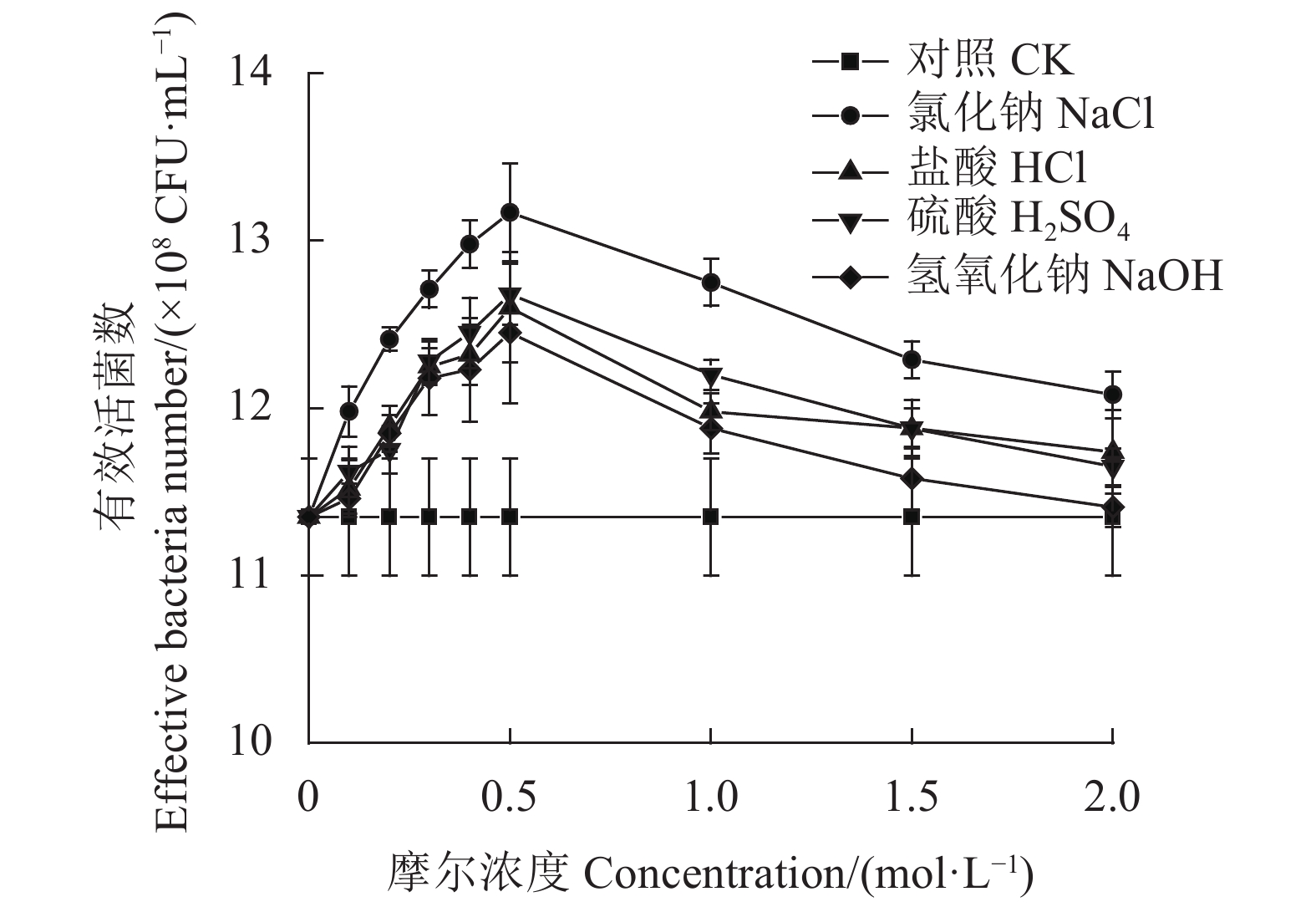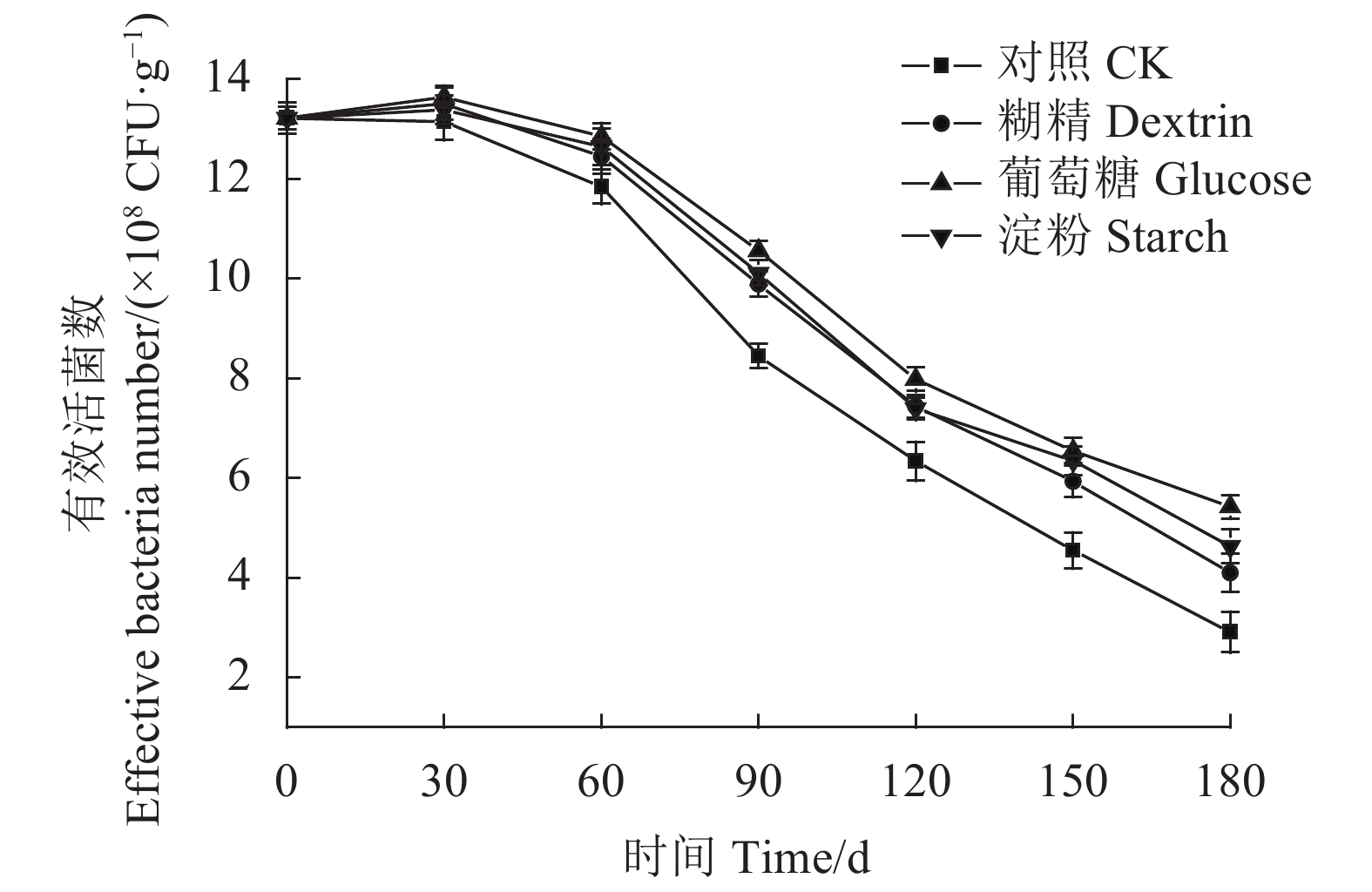Functional Improvements on Immobilization Carrier of Bacillus Culture for Natto Fermentation
-
摘要:目的 以麦饭石为载体,制备高效的纳豆芽胞杆菌固体菌剂,为纳豆芽胞杆菌的规模化应用奠定基础。方法 运用酸、碱、盐等方法探索麦饭石进行改性条件,扩大麦饭石孔隙度及比表面积,提升其吸附能力;并通过添加保护剂(葡萄糖、糊精、淀粉)增加保藏期固体菌剂的有效活菌数残留率,为长期保藏固体粉剂提供技术支持。结果 (1)确定了纳豆芽胞杆菌最适培养温度为40 ℃,最适培养pH为7.5。(2)经氯化钠、盐酸、硫酸和氢氧化钠溶液改性后的麦饭石吸附最大有效活菌数分别为13.17、12.6、12.7和11.9(×108 CFU·g−1)。其中0.5 mol·L−1氯化钠溶液改性效果最好,吸附有效活菌数达到13.17(×108 CFU·g−1)。(3)对照组、添加保护剂组(2%糊精、2%葡萄糖、2%淀粉)保藏至6个月时,有效活菌数分别为2.91、4.1、5.42和4.63(×108 CFU·g−1)。活菌数残留率为初始活菌数的22%、31%、41%和35%,其中2%葡萄糖保护剂比对照组有效活菌数残留率提高了1.86倍。结论 改性麦饭石能极大提升麦饭石的吸附能力,同时保护剂的添加有利于麦饭石固体芽胞杆菌粉剂的长期保藏,本研究为麦饭石在微生物菌剂制备工艺的应用提供了一定的技术支持。Abstract:Objective The physical properties of maifanshi, a volcanic rock, were modified to improve its porosity and adsorption to be used as an immobilization carrier for natto fermentation bacteria that was further added with protective agents to extend the shelf life of viable Bacillus natto.Method Maifanshi was treated by acid, alkali, or salt to modify the porosity and surface adsorption property as a microbial carrier. Various protective agents, such as glucose, dextrin, and/or starch were incorporated to help prolong the viability of the imbedded B. natto powder.Result (1) The optimum conditions for B. natto culture included 40 ℃ and pH 7.5. (2) The maximum viable bacteria count was the highest at 13.17×108 CFU·g−1 on the maifanshi carriers modified by 0.5 mol·L−1sodium chloride solution. It was followed by a count of 12.7 ×108 CFU·g−1 on maifanshi treated by sulfuric acid, 12.6×108 CFU·g−1 on maifanshi treated by hydrochloric acid, and 11.9×108 CFU·g−1 on maifanshi treated by sodium hydroxide. (3) The viable B. natto counts after 6 months in storage on control was 2.91×108 CFU·g−1 as compared to those immobilized on the carriers with addition of 2% dextrin, 2% glucose, or 2% starch being 4.1×108 CFU·g−1, 5.42×108 CFU·g−1, and 4.63×108 CFU·g−1, respectively. The retention of viable B. natto on the NaCl-treated maifanshi with the addition of dextrin was 31%, that of glucose 41%, that of starch 35%, and that of control 22%.Conclusion As a bacteria carrier, maifanshi could be significantly further improved on the adsorption capacity by modification such as NaCl treatment. With an addition of 2% glucose on the immobilized system, the retained viable B. natto count could rise 1.86 times over control in 6 months of storage. It appeared that this study had paved the way of developing a practical application of maifanshi for natto fermentation industry.
-
Keywords:
- Bacillus natto /
- maifanshi /
- modification /
- protectant /
- adsorption
-
0. 引言
【研究意义】双孢蘑菇Agaricus bisporus又名蘑菇、白蘑菇、洋蘑菇等,属于担子菌门、担子菌纲、伞菌科、伞菌目、蘑菇属,是一种世界性栽培和消费的食药用菌[1-4]。闽南地区是国内双孢蘑菇生产的主产区[5],截至目前当地双孢蘑菇栽培仍以农户个体式的季节性生产为主,栽培菌株包括As2796、W192、福蘑38等,均是福建省农业科学院食用菌研究所选育品种;2010年前后陆续有人尝试利用空调等温控措施反季节栽培双孢蘑菇,目前工厂化生产双孢蘑菇运行较好的企业包括福建金明食品有限公司、漳州市新发生物科技有限公司、漳州市九冬蘑菇产业园等,栽培菌株几乎都是W192。尤其对工厂化生产企业,生产品种单一存在一定经营风险。未来双孢蘑菇生产的发展趋势必然是工厂化周年生产。随着市场的发展,对多样化、高品质的双孢蘑菇需求日益旺盛,亟需更多优良的双孢蘑菇品种。杂交育种是现代食用菌育种的常规手段, 也是目前较有效的育种方法[6-9]。杂交育种成功一个非常重要的关键因素是选择合适的亲本[10-13]。因此,收集拟用于育种的双孢蘑菇品种,评价其生物学性状,分析其遗传背景,可为后期的杂交育种亲本筛选提供依据。【前人研究进展】拮抗反应是体细胞不亲和性的具体表现[14],可用于食用菌遗传特异性的鉴定,日本的食用菌品种登记制度也将其列为一个重要指标[15]。通过拮抗反应判断菌株间的亲缘关系,操作方便,结果也较直观、易辨认,但也存在一些缺陷,如不容易区分遗传背景近似的菌株[16-17],而且观察拮抗线时存在主观因素,因此鉴定菌株时采用拮抗反应需结合分子标记等方法。近年来,已陆续有学者利用分子标记技术对双孢蘑菇种质资源进行分类鉴定、辅助育种。王翠等[18]通过SRAP等3种分子标记,结合农艺性状的表型,表明特定标记与双孢蘑菇产、质量性状具有明显的关联性。林媛等[19]利用RAPD标记对40个双孢蘑菇品种进行亲缘关系鉴定,王金斌等[20]采用SSR分子标记鉴定了双孢蘑菇栽培菌株,王新新等[21]采用SSR标记对国内外不同来源的双孢蘑菇种质建立了分子身份证,顾敏等[22]对31份As2796的单孢分离株和8份代表性双孢蘑菇栽培菌株进行遗传多样性研究。【本研究切入点】闽南地区双孢蘑菇栽培菌株较单一,本研究以不同途径引进的9个双孢蘑菇菌株为试验材料,利用体细胞不亲和性试验和SSR分子标记对其进行亲缘关系的探讨,旨在为进一步收集保护双孢蘑菇种质资源、杂交亲本选择等提供理论依据和技术支撑。【拟解决的关键问题】本研究采用体细胞不亲和性试验和SSR分子标记相结合对收集的9个双孢蘑菇菌株进行鉴定与分析,以期更准确更科学鉴定收集的双孢蘑菇菌株,明确其亲缘关系,为后续的杂交育种亲本选择等研究工作奠定基础。
1. 材料与方法
1.1 试验材料
供试双孢蘑菇菌株具体见表1。
表 1 供试的双孢蘑菇菌株编号Table 1. Sample codes for A. bisporus germplasms编号
No.菌株名称
Strain来源
Origin1 As2796 漳州市农科所 2 W2000 福建省农科院 3 W192 福建省农科院 4 福蘑38 福建省农科院 5 福蘑52 福建省农科院 6 福蘑58 福建省农科院 7 901 制种户 8 A15 制种户 9 HK 香港 1.2 试验试剂
DNA提取试剂盒、琼脂糖H、SSR引物等由生工生物工程(上海)股份有限公司提供;6×DNA Loading Dye、DNA Ladder Mix(100-3000 bp)、POP-7TM Polymer、HiDiFormamide等购自ThermoFisher。
1.3 供试培养基
100 g马铃薯+60 g双孢蘑菇二次发酵晒干草粪料+20 g葡萄糖+18 g琼脂。
1.4 试验方法
1.4.1 培养基制作
将草粪料和去皮、切块的马铃薯分别放入锅中,分别加水0.5 L,在加热器上加热至沸腾,维持约20~30 min,用2层纱布趁热在量杯上过滤,滤液待用;将2种滤液混合,小火加热,逐步加入糖和琼脂,混匀,水补足至1 L,分装,121 ℃高压蒸汽灭菌20 min。
1.4.2 体细胞不亲和性试验
体细胞不亲和性试验参考文献[14]的方法进行。
1.4.3 供试菌株DNA提取
采用Ezup 柱式真菌基因组DNA抽屉试剂盒提取DNA。
1.4.4 PCR反应体系与条件
参考文献[21-23],选用12个SSR引物对供试菌株进行扩增。引物信息具体见表2,PCR反应体系组成:10 mmol·L−1 dNTPs 0.4 μL,5 U Taq酶0.3 μL,100 ng DNA 1.0 μL,10 μmol·L−1的上、下游引物各 1 μL,Taq Buffer(含MgCl2)2.5 μL,加ddH2O 至 25 μL。PCR扩增程序为:95 ℃预变性3 min:94 ℃变性30 s,60 ℃退火30 s,72 ℃延伸30 s,共10个循环;94 ℃变性30 s,55 ℃退火30 s,72 ℃延伸30 s,共35个循环;72 ℃延伸8 min,4 ℃ 保存。
表 2 供试菌株鉴定所用SSR引物Table 2. SSR primers for variety identification引物名
Primer序列(5′ to 3′)
Sequence(5′ to 3′)5′端修饰
5′end modification重复基序
Repeat motifs片段大小/bp
Fragment size退火温度/℃
Annealing temperatureAbSSR005-F CTCTGGGATATGGACGAGGA 5′6-FAM (GATGAG)6 118 56 AbSSR013-F GACTGCCTGATTGACGGATT 5′HEX (TA)6 162 57 AbSSR015-F CTCGAGTCGACGAAGGAAAC 5′HEX (GA)7 238 58 AbSSR016-F TGTCTGGTTTTGCTCACGTC 5′HEX (TC)12 242 55 AbSSR018-F TGGCTCTTTACAGCCTTGGT 5′6-FAM (CAT)6 122 55 AbSSR084-F CGACCCATCATCAACTTCCT 5′HEX (GAA)6 234 59 AbSSR6-F ACCACATTCTGGAAAACGAA 5′HEX (GCT)8 181 55 AbSSR36-F CGTTGATGGAGTTCACTGAG 5′HEX (GAAG)4(GAAAAG)(GAAG) 148 58 L11-F ATAAAAAAGCATAATCACAAATG 5′6-FAM (TC)13 228 50 L15-F GCAGGTCCAGTGTGAACGG 5′6-FAM (TCC)8 192 57 L17-F ATCCAATTCACCAACCAGC 5′6-FAM (A)11gagaataagaaattgaaaattg(A)16 186 52 L23-F CTTTTCAGGGGAAGACAACG 5′6-FAM (GTG)7 174 55 1.4.5 电泳检测和 STR检测
将扩增好的PCR产物进行琼脂糖凝胶电泳(2 μL样品+6 μL溴酚蓝),300 V电压下12 min,获取鉴定胶图,通过胶图确定模板浓度,加水稀释到毛细管电泳所需浓度,按照相关流程进行STR检测。
1.5 数据分析
体细胞不亲和性试验结果的判断参照NY/T1845-2010。使用Gene mapper4.1软件分析SSR数据,用MVSP软件进行聚类分析,并形成供试菌株的遗传聚类图。
2. 结果与分析
2.1 供试菌株的体细胞不亲和性分析
供试菌株间的拮抗反应存在一定差异,如图1所示。福蘑52、901、As2796等3个菌株间的拮抗反应明显,表现为菌丝隆起。W192和W2000无拮抗反应,这2个菌株与福蘑52拮抗反应明显,表现为拮抗线。福蘑58和W2000无拮抗反应,这2个菌株与901拮抗反应明显,表现为沟状。
根据体细胞不亲和性试验结果,拮抗反应具体结果见表3。可以看出,901与A15之间没有拮抗线,但与其他菌株均存在较明显的拮抗线,分为一组;HK、福蘑52两两之间及与其他菌株之间均有较明显拮抗反应,这2个菌株的亲缘关系可能较远,HK分为一组,福蘑52分为另外一组;W192、W2000、As2796、福蘑58两两之间没有明显拮抗线,初步认为这些菌株之间亲缘关系较近,分为一组;As2796与W192等没有明显拮抗线,但菌丝明显不同,单独分为一组。因此,通过体细胞不亲和性试验可以初步将供试菌株分成 5 组。
表 3 供试菌株间的拮抗反应情况Table 3. Antagonistic reactions among tested germplasms菌株
StrainAs2796
As2796W2000
W2000W19
2W192福蘑38
Fomo 38福蘑52
Fomo 52福蘑58
Fomo 58901 A15 HK As2796 As2796 − W2000 W2000 − − W192 W192 − − − 福蘑38 Fomo 38 − − − − 福蘑52 Fomo 52 + + + + − 福蘑58 Fomo 58 − − + − + − 901 + + + + + + − A15 + + + + + + − − HK + + + + + + + + − 注:‘+’表示有拮抗性;‘−’表示无拮抗
Note: + presence of antagonism; − absence of antagonism.2.2 供试菌株遗传相似系数分析
遗传相似系数是表示群体或个体间相似程度的度量值,相似系数越大,样本的遗传关系越近,反之则越远。本研究结果表明,9个供试菌株的遗传相似系数变幅较大(0.432~0.905),平均值为0.6721;其中W192与福蘑38、W2000遗传相似系数最大,表明这3个菌株在这9个引进菌株群体中的亲缘关系最近;而W192与901遗传相似系数最小,表明这两个菌株的亲缘关系最远。W192、W2000、福蘑58、福蘑38、As2796之间的遗传相似系数均≥0.8,远大于平均值,表明这几个菌株间的亲缘关系较近;从遗传相似系数数值分布可以看出(表4),遗传相似系数≥0.9占比8.3%,遗传相似系数≤0.5占比11.1%,遗传相似系数0.8~0.89、0.7-0.79、0.6-0.69、0.5-0.59占比各约20%,表明这9个菌株间具有一定的遗传多样性,遗传丰富度较高。
表 4 相似性系数Table 4. List of similarity coefficients菌株
Strain福蘑38
Fomo 38福蘑52
Fomo 52福蘑58
Fomo 58901 A15 As2796 HK W192 W2000 福蘑38 Fomo 38 1 福蘑52 Fomo 52 0.615 1 福蘑58 Fomo 58 0.9 0.595 1 901 0.541 0.588 0.629 1 A15 0.462 0.722 0.486 0.765 1 As2796 0.821 0.667 0.865 0.529 0.556 1 HK 0.526 0.686 0.5 0.667 0.743 0.571 1 W192 0.905 0.718 0.8 0.432 0.564 0.821 0.632 1 W2000 0.81 0.769 0.8 0.486 0.615 0.821 0.684 0.905 1 2.3 亲缘关系分析
如图2所示,结合相似性系数矩阵表,以相似性系数0.76为阈值,可将供试菌株分成4个类群,第一类群只有一个样本HK;第二类群有2个样本A15与901;第三类群只有一个样本福蘑52;第四类群最多,有5个样本,其中W2000,W192和福蘑38在相似性为86%的地方聚为一类,其中W192和福蘑38的相似性有91%;样本AS2796和福蘑58相似性只有87%。
3. 讨论与结论
形态标记是人们最早利用的遗传标记类型[24]。但对食用菌等大型真菌而言,其子实体表型受外部环境因素影响大,因此单纯借助形态学指标区分菌株间亲缘关系难度较大。通过体细胞不亲和性试验可以初步判断菌株间的亲缘关系。本试验的拮抗反应较明显,如HK、福蘑52两两之间及与其他菌株之间的拮抗反应均较明显,说明这2个菌株的亲缘关系较远;As2796、W192、W2000、As2796、福蘑58两两之间没有拮抗反应,说明这些菌株之间的亲缘关系较近;901与A15两个菌株均由国外育种公司选育而成,相互没有拮抗反应,二者亲缘关系可能较近,但与其他菌株之间的拮抗反应均较明显,表明这2个菌株与其他供试菌株的亲缘关系较远,这与菌种来源是相符的。
DNA分子标记目前已广泛用于食用菌品种鉴定[15-16,18-22]。SSR具有等位变异高、共显性、简便、快速、稳定的特点[25]。SSR技术在农作物品种鉴定、遗传多样性分析、辅助分子育种等方面得到大量应用[20-28]。本研究结合相似性系数矩阵表,以相似性系数0.76为阈值,可将供试菌株分成4个类群,表明这9个双孢蘑菇菌株具有一定的遗传多样性与遗传丰富度。
有研究报道体细胞不亲和性试验的分类结果与分子标记聚类分析的结果基本相同。唐传红等的[16]利用拮抗试验和RAPD分子标记技术分析了供试菌株的亲缘关系,结果表明2种方法的鉴定结论是一致。杏鲍菇[29],黑木耳[30-31]等的研究结果也佐证了这一结论。但杨和川等[15]对29个金针菇进行遗传多样性分析结果表明,大部分拮抗对峙试验结果与聚类分析结果一致,也存在不一致的。因此采用多种鉴定方法对供试菌株进行综合分析,可以得出更准确结论。本研究综合体细胞不亲和性试验和SSR分子标记技术两种方法对供试的9个双孢蘑菇菌株进行鉴定分析,结果表明两种方法所得到的结果基本一致。如HK与其他供试菌株均存在明显拮抗线,SSR分子标记聚类结果也显示HK与其他菌株平均相似系数仅为0.626,单独聚为一类;A15和901二者之间不存在拮抗反应,而与其他供试菌株均存在不同程度的拮抗反应,聚类分析结果显示A15和901相似系数为0.765,与其他菌株平均相似系数分别为0.614和0.579,这两个菌株遗传背景相近,而与其他供试菌株亲缘关系较远。
不同DNA分子标记方法的开发原理是有一定区别的,有时不同分子标记方法的聚类分析结果会存在一定的差异。杨军[32]综合ISSR和RAPD两种分子标记鉴定分析供试灰树花菌株,结果表明利用2种分子标记比单独使用分子标记鉴定的结果更准确。本研究是综合拮抗反应试验的分类结果与分子标记聚类分析的结果,可以考虑进一步采用其他分子标记验证本试验结果。
-
表 1 麦饭石改性前后吸附效果比较
Table 1 Maifanshi adsorption property after modification treatments
项目
Item天然麦饭石
Natural Maifan stone改性麦饭石
Modified Maifan stone改性条件
Modification conditions未改性
Unmodified0.5 mol·L−1 NaCl溶液
0.5 mol·L−1 NaCl solution吸附有效活菌数
Amount of bacteria absorbed/
(×108 CFU·g−1)11.35±0.35 13.17±0.44 初始纳豆芽胞杆菌
Bacillus natrius/
(×108 CFU·mL−1)13.68 13.68 吸附率
Adsorption rate/%83 96.3 注:数据为平均值 ± 标准差。
Note: Data are mean±standard deviation. -
[1] 林先贵, 胡君利. 土壤微生物多样性的科学内涵及其生态服务功能 [J]. 土壤学报, 2008, 45(5):892−900. DOI: 10.3321/j.issn:0564-3929.2008.05.016 LIN X G, HU J L. Scientific connotation and ecological service function of soil microbial diversity [J]. Acta Pedologica Sinica, 2008, 45(5): 892−900.(in Chinese) DOI: 10.3321/j.issn:0564-3929.2008.05.016
[2] 许杰龙, 张国霞, 许玫英, 等. 餐厨废弃物资源化利用的微生物技术研究进展 [J]. 微生物学通报, 2011, 38(6):928−933. XU J L, ZHANG G X, XU M Y, et al. Research progress on reuse of food waste with microbial technology [J]. Microbiology China, 2011, 38(6): 928−933.(in Chinese)
[3] THATOI H, BEHERA B C, MISHRA R R, et al. Biodiversity and biotechnological potential of microorganisms from mangrove ecosystems: A review [J]. Annals of Microbiology, 2013, 63(1): 1−19. DOI: 10.1007/s13213-012-0442-7
[4] 朱永光, 杨柳, 张火云, 等. 微生物菌剂的研究与开发现状 [J]. 四川环境, 2004, 23(3):5−8, 12. DOI: 10.3969/j.issn.1001-3644.2004.03.002 ZHU Y G, YANG L, ZHANG H Y, et al. Progress of research and development of microorganisms agents for bioaugmentation [J]. Sichuan Environment, 2004, 23(3): 5−8, 12.(in Chinese) DOI: 10.3969/j.issn.1001-3644.2004.03.002
[5] 李静, 谭月臣, 洪剑明. 固定化微生物技术处理废水 [J]. 安徽农业科学, 2010, 38(25):13981−13983. DOI: 10.3969/j.issn.0517-6611.2010.25.161 LI J, TAN Y C, HONG J M. Use of microorganism immobilization technology in wastewater treatment [J]. Journal of Anhui Agricultural Sciences, 2010, 38(25): 13981−13983.(in Chinese) DOI: 10.3969/j.issn.0517-6611.2010.25.161
[6] 张陇利, 刘青, 徐智, 等. 复合微生物菌剂对污泥堆肥的作用效果研究 [J]. 环境工程学报, 2008, 2(2):266−269. ZHANG L L, LIU Q, XU Z, et al. Research on effect of compound microbial inoculant on sewage sludge composting [J]. Chinese Journal of Environmental Engineering, 2008, 2(2): 266−269.(in Chinese)
[7] 勾长龙, 高云航, 刘淑霞, 等. 微生物菌剂对堆肥发酵影响的研究进展 [J]. 湖北农业科学, 2013, 52(6):1244−1247. DOI: 10.3969/j.issn.0439-8114.2013.06.002 GOU C L, GAO Y H, LIU S X, et al. Investigation and application progress of inoculating microbes on aerobic composting of manure [J]. Hubei Agricultural Sciences, 2013, 52(6): 1244−1247.(in Chinese) DOI: 10.3969/j.issn.0439-8114.2013.06.002
[8] 官赟赟, 顾锡慧, 雷太平, 等. 炼油废水COD降解菌固态菌剂的制备及性能考察 [J]. 工业水处理, 2016, 36(2):75−78. DOI: 10.11894/1005-829x.2016.36(2).075 GUAN Y Y, GU X H, LEI T P, et al. Study on the preparation and performances of solid bacteria agent of COD degrading bacteria of refinery wastewater [J]. Industrial Water Treatment, 2016, 36(2): 75−78.(in Chinese) DOI: 10.11894/1005-829x.2016.36(2).075
[9] 王微, 李圆萍, 谢惠玲, 等. 铜绿假单胞菌菌剂载体的筛选 [J]. 福建农林大学学报(自然科学版), 2016, 45(3):325−330. WANG W, LI Y P, XIE H L, et al. Screening of carrier for Pseudomonas aeruginosa bacterial agent [J]. Journal of Fujian Agriculture and Forestry University (Natural Science Edition), 2016, 45(3): 325−330.(in Chinese)
[10] 赵旭, 王改兰, 陈春玉, 等. 谷糠和堆肥作为微生物菌剂载体的研究 [J]. 安徽农业科学, 2015, 43(14):179−180, 223. DOI: 10.3969/j.issn.0517-6611.2015.14.069 ZHAO X, WANG G L, CHEN C Y, et al. Study of bran and compost as a carrier for microbial inoculants [J]. Journal of Anhui Agricultural Sciences, 2015, 43(14): 179−180, 223.(in Chinese) DOI: 10.3969/j.issn.0517-6611.2015.14.069
[11] 高书锋, 刘惠知, 胡新旭, 等. 畜禽用凝结芽孢杆菌菌剂制备工艺的初步研究 [J]. 饲料工业, 2012, 33(13):37−40. DOI: 10.3969/j.issn.1001-991X.2012.13.009 GAO S F, LIU H Z, HU X X, et al. Preliminary researches on preparation techology of Bacillus coagulan strain applied to animal [J]. Feed Industry, 2012, 33(13): 37−40.(in Chinese) DOI: 10.3969/j.issn.1001-991X.2012.13.009
[12] 李娟, 张盼月, 高英, 等. 麦饭石的理化性能及其在水质优化中的应用 [J]. 环境科学与技术, 2008, 31(10):63−66, 75. DOI: 10.3969/j.issn.1003-6504.2008.10.016 LI J, ZHANG P Y, GAO Y, et al. Overview of Maifanshi: its physi-chemical properties and nutritious function in drinking water [J]. Environmental Science & Technology, 2008, 31(10): 63−66, 75.(in Chinese) DOI: 10.3969/j.issn.1003-6504.2008.10.016
[13] 陈丽红, 张翔凌, 何春艳, 等. Zn-LDHs覆膜改性麦饭石对Cd(Ⅱ)吸附性能及其作用机理研究 [J]. 环境科学学报, 2019, 39(12):4004−4014. CHEN L H, ZHANG X L, HE C Y, et al. Adsorption behavior and mechanisms for Cd(Ⅱ) by modified maifanite coated with Zn-LDHs [J]. Acta Scientiae Circumstantiae, 2019, 39(12): 4004−4014.(in Chinese)
[14] 陈琳荔, 邹华. 改性麦饭石对水中氮磷的去除 [J]. 食品与生物技术学报, 2015, 34(3):283−290. CHEN L L, ZOU H. Experimental study on removal of ammonium and phosphate in simulation river water by modified Maifan tone [J]. Journal of Food Science and Biotechnology, 2015, 34(3): 283−290.(in Chinese)
[15] 张琪. 枯草芽孢杆菌固定化载体的改性条件及处理模拟污水[D]. 哈尔滨: 哈尔滨理工大学, 2014. ZHANG Q. The modified conditions of Bacillus subtilis immobilized carrier and the treatment of simulated sewage[D]. Harbin: Harbin University of Science and Technology, 2014. (in Chinese).
[16] 陈龙军, 林陈强, 张慧, 等. 纳豆芽胞杆菌Bacillus natto菌剂载体的筛选 [J]. 福建农业学报, 2018, 33(10):1104−1107. CHEN L J, LIN C Q, ZHANG H, et al. Selection of carrier for dried Bacillus natto [J]. Fujian Journal of Agricultural Sciences, 2018, 33(10): 1104−1107.(in Chinese)
[17] 常金梅, 蔡芷荷, 吴清平, 等. 菌种冷冻干燥保藏的影响因素 [J]. 微生物学通报, 2008, 35(6):959−962. DOI: 10.3969/j.issn.0253-2654.2008.06.024 CHANG J M, CAI Z H, WU Q P, et al. Influencing factors to freeze-drying preservation of culture [J]. Microbiology, 2008, 35(6): 959−962.(in Chinese) DOI: 10.3969/j.issn.0253-2654.2008.06.024
-
期刊类型引用(3)
1. 连燕萍,赵光辉,吴振强,袁滨,柯丽娜,张志鸿. 卵孢小奥德蘑菌株的拮抗及ISSR遗传分析. 热带农业科学. 2023(01): 15-20 .  百度学术
百度学术
2. 袁滨,柯丽娜,连燕萍,赵光辉,林德锋,陈光祥. 适宜温控菇房的双孢蘑菇菌株筛选. 热带农业科学. 2022(03): 16-19 .  百度学术
百度学术
3. 卓蕾,向成丽,肖杰,叶媛丽. SSR标记在植物种质资源鉴定的应用进展. 现代园艺. 2021(15): 9-11 .  百度学术
百度学术
其他类型引用(0)




 下载:
下载:







